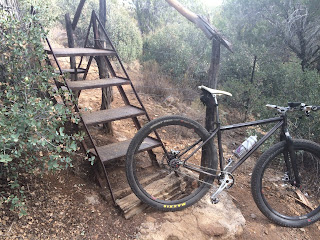OK nerds, are you ready?
Last time we were talking about Quadrant Analysis and how SS
MTB’s force you into all quadrants much more than say geared road bikes. And that being the case, it provides a more
well-rounded workout. Between then and
now, I’ve had a chance to get my Wahoo Elemnt Bolt up and running which has enabled
a few things….first, it connects to my HR strap and my PWR meter so I can
collect that data simultaneously.
Secondly, it allows me to display my power real time which then enables
me to adjust my effort…all cool stuff. (and a freaking awesome unit...garmin should be worried).
So last Friday (day before the AES Tusayan Tussle Race), I
made a fast run up to Crystal Pt. which contrary to popular belief, is not a
meth house…It’s our little jewel of singletrack here in Munds Park which climbs
about 800ft. Perfect for a Z5+ run and
to loosen up the legs. The entire climb
is a bit over 14 minutes and is split into 2 sections, a flatter section with a
few ups, then a steady grade with switchbacks to the top.
Since we looked at the QA stuff before, let’s look at the cadence
distribution for a little insight…
Interesting! The whole ride is two
distinct distributions(cyan colored) and the lighter grey colored one is the steeper
switchback section which is almost entirely standing pedaling (w/ a
34-19). This I believe actually shows
that in between area well which for my case is around 75 rpm (too steep to sit
and mash, too easy to stand).
Now let’s look at the Tusayan Tussle file…almost 5 hours of
data! Wow, this one took a few beers to
digest. Here’s the quadrant plot…as you
might expect, tons of scatter. That race
was actually fairly flat and my gearing was 34-19. You can see from the plot that I spent over ½
the time sitting and generating power in Z2. (lower right hand quadrant and below the curved line which is 250W)(Contrast that to a Flagstaff climbing ride where over 50% of the time is spent in the upper left quadrant).
The cadence distribution on that one looks similar except
the middle area is a bit more filled in.
However, if I look at the first 45 minutes or so which was
flattish with a slight uphill grade you can see the familiar “bimodal” look to
the distribution which again shows seated and standing cadences.
This section btw, I was clawing my way back
up from 6th place and had my eyes glued to the 5 second pwr avg
trying not to let it get too high and burn all my matches. (it was very useful
for that since when you see someone in front of you, you wanna close that gap fast!).
The other interesting thing to notice from that race is how
my average power trended over the entire 5 hours… Below is a plot where I plotted the 1000 second average (almost a 17 minute average). You can see that I was chasing in that first
part of the race then backed off until near the end where I then could smell
the beer at the finish. This is
interesting…I’d love to think with training I can keep the power consistent or
maybe with at least a bit more “control” I could do so. More thinking about this to be done…
Finally, to help address the bi-modality of the cadence data,
I did some seated intervals up Waterline Rd where I targeted about 225W for
durations of 5 minutes. I’m thinking
that with some work in this area, I can improve my seated power when I’m in
that “in-between” area. Here’s what the overall quadrant plot looks like with one of those 5 minute intervals selected…note how
the seated pedaling interval(Green Points) has such a tight cluster(and fairly near the 250 W curve)
The Tusayan Tussle race was a flattish course and I was not trained very well to do it...I didn't have the endurance I should have (hence the fall-off in the power data) plus almost all my training rides are 50% or more standing and very little in the lower right quadrant. I believe mixing in some seated intervals as I did today will help...and BTW, my legs are shredded from them....obviously a weakness I can address.
Now that I have HR data along with PWR data, it will enable me to play around with something called aerobic decoupling...which is basically a measure of aerobic fitness. I think my lack of some longer training rides has impacted my ability to keep generating steady power late in these 4-6 hour races.
I know some of you are like, "You're wasting your time you dumb f*ck! Just go ride your bike!"....Yeah...whatever...I've ran out of f*cks for you.
AR




























































